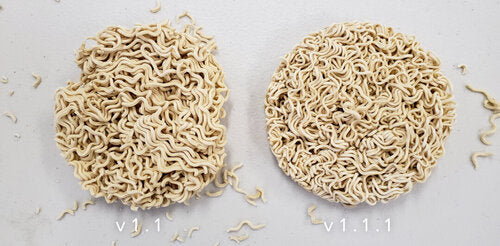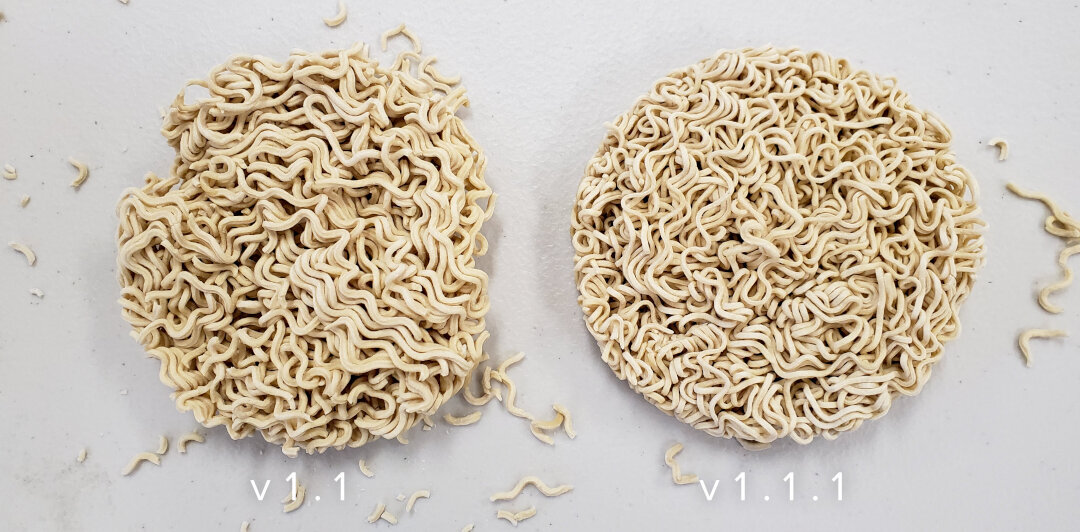
Vite Ramen Version 1.1.1 Mini Patch Notes - Noodle Improvements!
Share
A new patch is now live on Windows PC, Xbox, and Playstation v1.1-- We’re improving the noodles again! This patch will be designated as v1.1.1 as it’s an ingredient and process change, rather than a formula change. All packages with the lot code IAF and onwards will have these changes. Note: Packages and shop listings will continue being labeled v1.1, as this isn't a big enough change to do new labels for!
What's Changed?
-
Noodle diameter thinned out from 1.75mm to 1.5mm
-
Or 0.0590551 inches from 0.06889764 inches
-
Or 0.0000010874 miles to 0.0000010874 miles
-
Did those conversions really help anyone
-
Canadian Golden Quinoa being used instead of Bolivian Quinoa. Varietal changes explained below.
-
No, that does not mean we’re shipping to Canada yet
-
sorry :'(
-
Heat treating removed
-
Still hot though
-
Assuming you’re cooking it
-
No judgement from us if you’re one of the of raw ramen men and enjoy the cronch

Why has the noodle diameter changed?
We’ve received feedback that often, 3 minutes might not be enough to get the noodles to the texture that most people like, mostly, but not always, from people who make their ramen in the microwave. Since microwave power varies hugely, it definitely makes it difficult to cook the ramen in a set amount of time.
As a bonus, most people actually preferred the texture and chew of the thinner noodles as well, in both a straight no-broth taste test as well as a with-broth taste test.
Thinner noodles = more surface area = more broth being picked up = more flavor per bit. Yum.
We also found by reducing the noodle diameter, it not only allows the ramen to hydrate faster in a microwave, but also has the added bonus of staying together better during shipping, and not crumbling as much. Weird, right? You’d think it would be the opposite effect.
But, as we’ve learned, a thinner noodle can intertwine with other noodles more readily, meaning it forms a stronger noodle brick, sort of like how thin ropes can be made stronger by braiding it. The more intertwined noodles actually end up stronger and less prone to breakage than the thicker noodles because of this.
Quinoa Improvements
We’ve also switched to Canadian Golden Quinoa instead of Bolivian and Columbian quinoa. Bolivian and Colombian quinoa are heartier and nuttier in flavor, which is good for people who like quinoa a whole bunch, but we want to minimize quinoa’s taste in our ramen to try and get it as close to standard wheat noodles as possible.
They also have more of the enzyme present called saponin that some people taste as a bitter, herbal taste, which is nice in a salad, but not as nice in ramen. By switching to Canadian Golden Quinoa, we’re able to make the noodles have a significantly more neutral flavor!
The thing about saponin is that it also does matter how well the quinoa is hulled and washed before it’s milled into flour! Any traces of the hull that make it into the flour will increase the bitterness many times over. The new supplier we’re working with for the quinoa processes the Golden Quinoa significantly more thoroughly, which also helps with the neutral, non-bitter flavor!
Another cool thing about Canadian Golden Quinoa is that it has a starchiness to it which is generally undesirable in many other quinoa uses, but works perfectly in our ramen as it helps work to bind the noodle, and also works to help smooth the noodle texture out, which should lead to an improved slurp.
Heat Treating
Previously, we had also utilized heat treating for our quinoa. This was used in order to help destroy the enzyme that caused the bitter, herbal taste, as it’s destroyed by heat. Some preparation methods, like microwaving or hot water pour overs aren’t always enough heat and time to destroy the enzyme, which is why we wanted to be able to take care of it beforehand.
One of the side effects of this heat treating process, however, was that we’d often get varying degrees of heat treatment, which reduced consistency. Some batches of quinoa would be a deep orange and smell almost like Cheez-Its because of the heat treatment, while others would arrive ghostly pale, with a more distinct herbal note to it. This also made it more difficult to control hydration levels, as quinoa flour that’s been heated for a long time has significantly less moisture(up to 50% less!) than quinoa flour that has not been heat treated.
However, with the new quinoa, we have a much more consistent quinoa, which makes heat treating no longer necessary! Having the better processing from the new supplier makes things a whole lot easier.
Anyway, that about wraps up the changes we’ve made, as well as the rationale behind them. Leave us a comment, or message on any of our social media or email us directly if you have any more questions!
